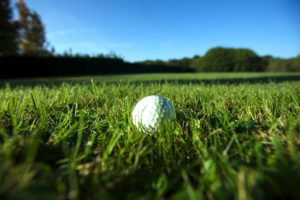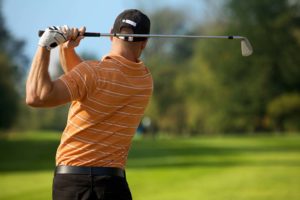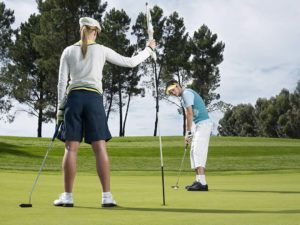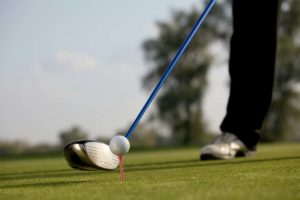As a novice, you probably thinking of how to use a rangefinder is a piece of cake. While you aren’t quite far from the truth, it isn’t as easy as you might imagine. While learning how to use a golf rangefinder, there are several steps involved.
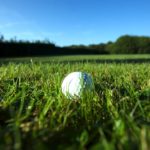
Rangefinders are among the many gadgets designed to assist golfers.
Having a golf rangefinder isn’t enough; knowing how to use a rangefinder it makes all the difference. They are the most commonly used golf devices.
With some practice, using these devices is quite easy. Of course, there are rules and restrictions governing the use of these devices.
However, the rules aren’t hard to understand. To learn how to use a rangefinder, let’s follow the step below.
How to Use a Golf Rangefinder
The first thing, purchase a good rangefinder
Even before you start learning how to use a golf rangefinder, you need to buy the right model. In that case, you have to know some basics on how to choose the right option.
First, ensure you purchase a golf rangefinder whose maximum distance exceeds your course range.
There’s a difference between hunting and golf rangefinders. For that reason, you should also know the difference before buying.
There are fundamental differences between hunting and golf rangefinders. Although some work for both tasks, not all rangefinders perform in both situations.
My professional advice, stick to something purely designed for golfing. This is because some of the features meant for hunting might not be of any help to you as a golfer.
For instance, hunting rangefinders often have an extended range of like 1000 yards. This might be useless for golfers.
Another thing, golf rangefinders often have specialized features like slope and pin seeker which might not be available with hunting rangefinders.
For that reason, sticking to specialized golf rangefinders would be a wise idea.
What next after making a wise purchase?
When making a purchase, also differentiate between laser and GPS rangefinders. Both have their benefits and flaws. For that reason, settle for the option which suits your needs.
For instance, laser rangefinders are more accurate than GPS. However, the GPS options offer ease of measuring distances.
With laser rangefinders, you will need to stay steady. However, with the GPS, you use GPS technology. Therefore, you don’t need stability in your hands.
These are some of the factors you consider when choosing between a GPS and laser rangefinder.
-
Know the purpose
Before you start using your rangefinder, know your purpose for having it. Different rangefinders offer different functions. We have simple and sophisticated options out there.
For a beginner, you might not need all those sophisticated features at the moment.
Rangefinders perform different tasks. For instance, they determine location, hazards, and distance of tee, greens, bunkers, and flag post.
To get the best results, you should practice for a single goal at a given time.
After you have acquired a single skill and mastered it, then you can proceed to the other skills.
This way, you will learn faster and get different functions with ease. However, combining all the functions might not offer the desired results.
-
Master the techniques
When using laser rangefinders, there are several additional features for easy operation and target determination.
For instance, there’s a range-finding button, the display reticule, and the range. For perfect results, one needs to master all these skills.
Explore the many tricks available on the rangefinder. You could do this with the assistance of a professional or a friend.
Alternatively, you could use the user manual included in the package. By correcting the reticule using the ranging button, you easily prevent error when viewing hills or obstacles.
For that reason, mastering these skills helps you get the best out of your rangefinder. Another important feature to master is the pin seeker technology.
How does it work? With this feature, you determine whether the flag is measuring the distance to the trees around the flag or the target.
The locking technology captures the target for perfect measurement determination.
With the continuous indirect measurement feature, other rangefinders offer the distance between two points on the course.
When using this feature, you aim the rangefinder on the target the continuously press the power button or the ranging button.
We also have new features, so you should check the manual for more details. Trying out all the tricks on the manual puts you at a better place to get better performances.
-
Be sure of your location
In most cases, your rangefinder might calculate distances beyond where you are located. In this case, knowing your distance helps you.
Although this might not seem crucial, it is an important factor. The rangefinder could even measure a distance less than the actual distance.
So, you should know your location on the course. This way, you know when there’s an error and adjust to bridge the difference.
-
Start using and practice
After knowing all these tricks, it’s time to start using and practicing. They say practice makes perfect. So, you should practice more to get the best results.
Since rangefinders come with adjustable magnifications, ensure you adjust them correctly. This way, you will get perfect measurements.
-
Learn to adjust your eye hole
The main aim is to learn to use the eye relief function on the rangefinder. Of course, placing the eye hole in the wrong position causes discomfort and poor results.
While acquiring targets and locking might appear easy for experts, learners still find it hard. However, with some practice, you will easily acquire a target and lock it with ease.
When starting, measure distances of like 100 or 50 yards from the flag. This way, you can train then keep adjusting the yardage with time.
At the end of the day, you will have improved your skills and will have better yardage skills.
Another trick to sharpening your skills is having a professional help you while training.
With a professional, you will get the right skills and also learn from their knowledge. A professional will also confirm if your device is in the right shape or not.
Although aiming and shooting might appear like an easy task, it will take some practice.
However, with time, you will get the best results. Regularly refer to the manufacturer manual when training. You could also watch video tutorials on YouTube to sharpen your skills.
How to read a golf rangefinder
When learning how to use a golf rangefinder, you also need to know how to read the device. So, how do you read a golf rangefinder?
In this case, we shall look at the GPS and the laser rangefinders. Reading laser rangefinder isn’t the same as reading a GPS rangefinder.
For laser rangefinders, you first turn it on. After that, you can choose the mode or the slope function if needed.
After making all the necessary adjustments and changes, place the device on your eyes, capture the target, then press the button.
To read the measurements, you simply look at the calibrations on the reading surface. This clearly shows the distance of the flag from the ball.
In other courses, there’s a small reflective device placed on the flagstick for perfect reflection of beams of light. This way, reading becomes easier.
As for GPS rangefinders, reading the distance is easy. You only refer to the display screen.
Since it uses GPS information, you get data without the need for laser beams. However, the distance might not be quite accurate.
The first step is loading the course on the GPS rangefinder.
Although most GPS golf rangefinder comes with pre-loaded maps, you can still download specific ones from the internet. With the loaded maps, reading the slopes, flagstick, and flags becomes easy.
After loading the map, you now turn on the device once you are on the course. With the satellite connection, you get improved data.
To read measurements, simply choose the target hole and slope. With GPS rangefinders, the data is displayed with ease.
You could also use the map to determine your coordinates for easy distance determination.
How about reading distances using optical rangefinders?
These ones are a bit inaccurate. However, golfers still use them. In this case, you look through the sight then move the knob if it is available till you get a clear vision.
After carefully adjusting the knob, you will get the distance. Although they give an idea of the distance, they are quite inaccurate.
They give approximations but not actual distances to the target.
In Summary
When learning how to use a golf rangefinder, first determine the type. GPS and laser rangefinders have different ways of using.
We also have optical rangefinders, which are slowly becoming obsolete. This article offers information on how to use a rangefinder, all of them.
Till next time!
More Information
Last Updated on December 4, 2023 by Paul Roger Steinberg

